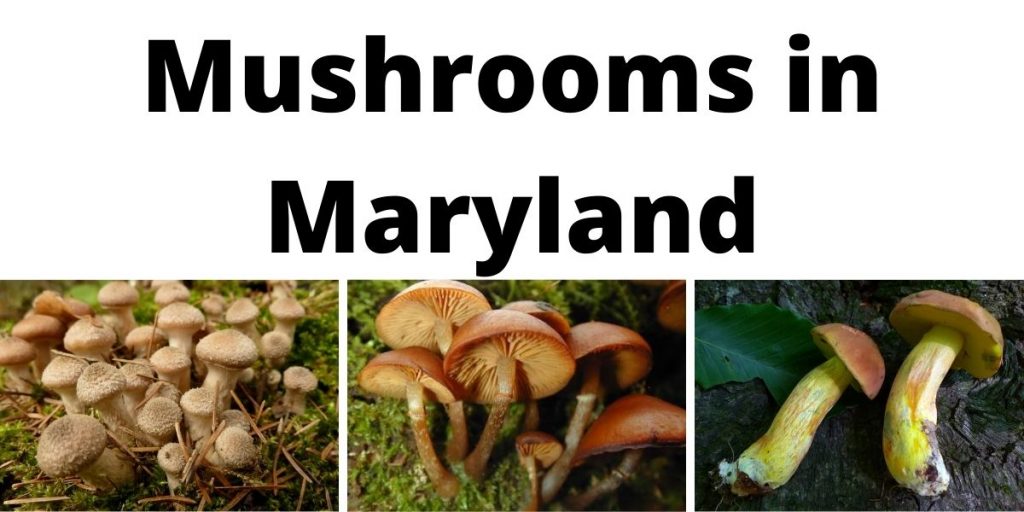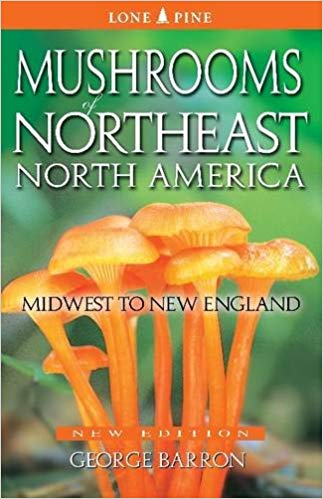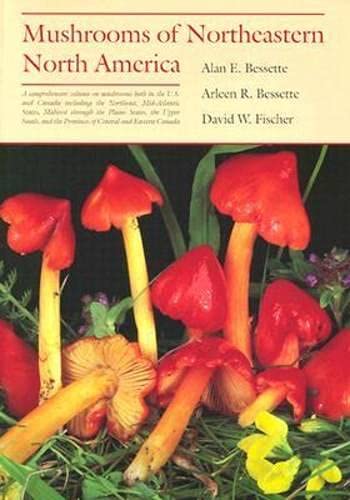Maryland prides itself on being “America in miniature,” as the state is quite small, yet stretches from coastal beaches west to forested mountains. Of course, America as a whole also has prairies and Maryland does not—instead of grass, its center is occupied by water, the wide and shallow ecological and cultural treasure known as the Chesapeake Bay. Mushrooms do not grow in the bay, but they grow everywhere else, from clusters of earthstars in sand dunes to tiny Birds Nest Fungi in mulched garden beds to the big and shaggy Lion’s Mane that tastes a bit like Maryland’s famous blue crab!
We can’t list all of Maryland’s mushrooms here, there are too many[i][ii], but we can introduce a few of its more sought-after species (plus a few that are best carefully avoided).
Our Recommended Field Guides for Maryland
COVER | TITLE | Header | ||
|---|---|---|---|---|
OUR #1 RATED | ||||
Edible Wild Mushrooms in Maryland
Please don’t eat wild mushrooms just because this article says they are edible. It’s absolutely essential to put the time and effort in to developing real expertise at mushroom identification before harvesting anything for the table. It’s not that mushrooms are difficult to tell apart—although some are—it’s that mushrooms are so unfamiliar to most people that non-experts don’t really know how to look at them and might overlook key differences or skip crucial identification steps.
Some people will disagree, saying that they know this one species and can therefore harvest it, or that all morels are edible and nobody could mistake a morel for anything else. But we repeat our warning; real expertise is necessary. For example, there are stories of people who died because they were entirely familiar with an edible mushroom that had no local look-alikes, but then either the people went somewhere else where a toxic look-alike did grow, or a toxic look-alike was accidentally introduced from somewhere else. Had these people been more familiar with mushrooms as a group, they would have noticed they were dealing with an unfamiliar species and would not have gotten poisoned.
And then there are all the mushroom species that are edible in some circumstances and toxic in others. It’s a lot to learn.
If you do indeed go Mushroom Hunting make sure you have the proper tools, take a quality knife with you and a basket/bag for your haul!
This list is not meant to be used as a replacement of a field guide, spore prints, an identification app or an in person guide.
The point of this article is that there’s lots of really cool mushrooms out there that are worth learning about.
Morels (Morchella sp.)
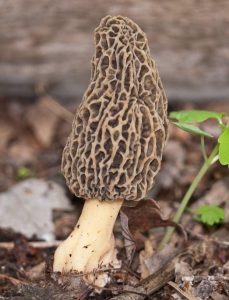
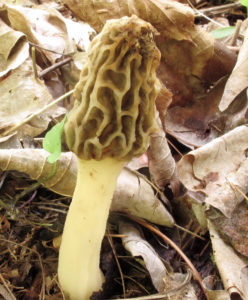
Morels have an entirely undeserved reputation for simplicity. “Everybody knows” that morels as a group are easy to identify and all safe and delicious to eat. It’s true they are distinctive-looking, with narrow caps as deeply pitted as a honeycomb. But the group does have its look-alikes, some of which are toxic, and morels themselves sometimes make people ill (even if the mushrooms are properly cooked) and nobody yet knows why.
Even telling one morel species from another is challenging, since some resemble each other so closely that they share the same common name, while others are so variable that a single species has been given multiple common names. Morel taxonomy is in fact still being worked out.
Maryland has at least two morel species, both of them pale yellow: M. americana and the smaller M. diminutiva.
Chanterelles (Cantharellus sp.)
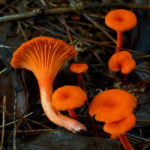

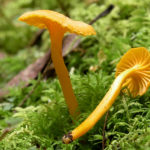
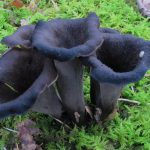
The chanterelles are another easy-to-recognize group, since they all more or less share a distinctive trumpet shape with ridges, rather than gills, on the outer surface of the flared-out “bell.” The trumpets are a very similar group that are sometimes included with the chanterelles—both are edible, though the trumpets are usually not quite as good. However, there are mushrooms that have ridges that are not chanterelles and are not safe to eat, plus beginners often don’t see the difference between gills and ridges, leaving people vulnerable to toxic mistakes. Chanterelles are a great example of why real familiarity with mushrooms is necessary before foraging for the table; to a beginner, toxic jack o’lantern looks like a chanterelle, while to an expert, someone used to noticing mushroom detail, it doesn’t.
Maryland has at least three chanterelle species: Red Chanterelle (C. cinnabarinus), which is red or pink and often quite small; Smooth Chanterelle (C. lateritius), which is yellowish and larger but variable; and Small Chanterelle (C. minor), which is yellow to orangish and not only short but very slender. Plus, Maryland is also home to a trumpet, one of the several called Black Trumpet (Craterellus fallax). It has thinner, drier flesh than the true chanterelles do, but is still good to eat.
Honey Mushrooms (Armillaria sp.)
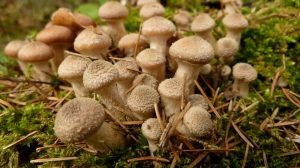
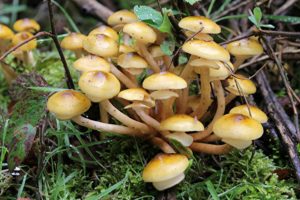
Honey mushrooms are named for their color, not their taste, but they are considered a prized edible—except that they are toxic to a small minority of those who eat them. There’s no way to know who will react badly, so some authorities no longer consider this edible. That being said, Maryland has two species. Both are brownish. The Bulbous Honey Mushroom (A. gallica) has a swollen stem base while Honey Mushroom (A. mellea) does not.
Boletes
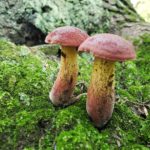

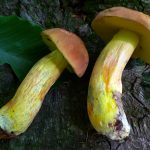

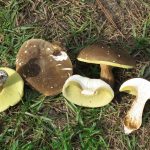
Originally, all mushrooms that had both the classic toadstool shape and a pore surface rather than gills were put in the Boletus genus. That genus has since been divided up, but these mushrooms are still referred to casually as boletes. Some are edible. Some are mildly toxic, unpalatable, or simply of unknown status. Maryland has at least eight of these mushrooms. Five are known to be edible.
Bicolor bolete (Baorangia bicolor) is mostly red with a yellow pore surface and reportedly pairs well with red meat[iii]. It is harder to differentiate from its close look-alikes than often supposed because these mushrooms are more variable than some field guides give them credit for[iv]. At least none in the group of look-alikes are known to be toxic.
Butter-foot bolete (Boletus auripes) has a golden brown cap, a yellow stem, and a pale yellow pore surface that darkens with age[v]. It is reportedly a choice edible and subtly pretty besides.
Lanmoaoa pseudosensibilis[vi] has no common name. It is mostly golden brown also, but the yellow flesh stains blue when cut, and the yellow to brown pore surface bruises blue, but the bruises fade to brown. It is considered good though not choice.
Lilac bolete (Boletus separans)[vii] generally has a brownish cap, a whitish and brownish stem, and a pore surface that is initially white, then yellowish, then brownish with age. But the whole mushroom usually has a lilac tinge. It is considered choice, with a sweet and nutty flavor.
Boletus variipes[viii] has no common name of its own, but is one of several species so similar to B. edulis that they might reasonably share its common names of king bolete or porcini. And with a name like “king,” it’s no surprise that it’s a choice edible. It is pale brown with a paler pore layer.
Poisonous Mushrooms in Maryland
The following list is not exhaustive—don’t assume something’s edible just because it’s not here! Don’t assume generally—rules of thumb about mushroom edibility all have exceptions, and exceptions can get people killed. The only way to know whether a mushroom is poisonous is to find out what kind of mushroom it is.
Eastern Destroying Angel (Amanita bisporigera)
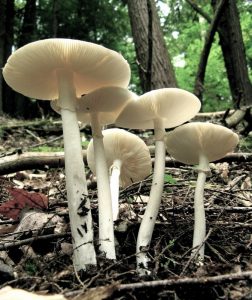
As the name implies, this is among the most toxic mushrooms in the world[ix]. Potency varies, but a single specimen often can kill an adult human. The toxin can take a day or more to kick in—meaning some poisoning victims don’t realize the mushroom they ate could be the culprit and don’t think to tell their doctor about it. The initial symptoms pass after a few days. But although the patient feels better, the poison is still active, busily destroying the liver and sometimes the kidneys. Poisoning victims should not give up hope, though; some do survive with prompt and appropriate medical care. There are several destroying angel species, and all are large, handsome mushrooms, usually white but sometimes pale tan, pink, or yellow. The eastern destroying angel is simply the one documented from Maryland.
Eastern Jack O’Lantern Mushroom (Omphalotus illudens)
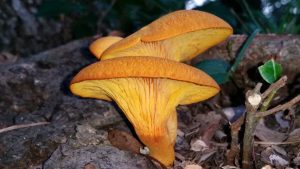
The eastern jack[x] is one of several very similar species worldwide that all share certain things in common: they glow (very faintly); they make anyone who eats them very, very sick; and they bear a vague but real resemblance to some of the most sought-after edible mushrooms in the world.
Deadly Galerina (Galerina marginata)

Maryland’s most dangerous species may be the well-named Deadly Galerina[xi]. Not only does it contain the same toxin as the destroying angel[xii], but it is a close look-alike of many edible and psychoactive species—and in some cases, it can even fruit mixed in with flushes of sought-after species. Any LBM, or “little brown mushroom,” should be very carefully examined, every single mushroom, every single time, because mistaken identification could kill you.
Magic Mushrooms in Maryland
There is a rumor going around, repeated by seemingly reliable sources, that Maryland has no psilocybin mushrooms. The rumor is not true[xiii]. While Psilocybe cubensis does not grow wild in Maryland (the climate is too cold), other psychoactive species do—one is even a member of the Psilocybe genus. Perhaps the rumor was spread by people who don’t understand mushroom taxonomy well enough to realize “Psilocybe cubensis” doesn’t refer to all psychoactive species? In which case, they should not go mushroom hunting. All the cautions about developing real expertise before going foraging apply to “magic” mushrooms, too—people have died by eating what they thought was a magic mushroom and wasn’t.
The other thing to keep in mind is that using or possessing mushrooms with psilocybin is illegal in Maryland at both the state and federal level. Penalties can be severe.
Panaeolus
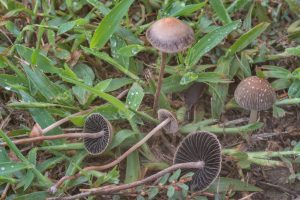
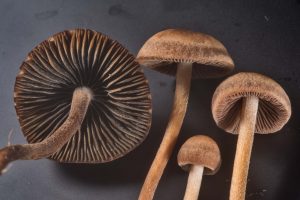
Mushrooms in the genus, Panaeolus[xiv] are called Mottlegills, because the spores develop and darken in uneven patches. Not all are psychoactive, and some sources list those that are in a separate genus, Copelandia. Some of those that are have very high potency, while others are very weak. Maryland’s two are low-potency.
The Turf Mottlegill (P. fimicola)[xv] is really only marginally psychoactive and may also be mildly toxic. It’s best avoided. The Banded Mottlegill (P. cinctulus)[xvi] is more reliable, but still so weak that it is mostly only of use when microdosing.
Psilocybe
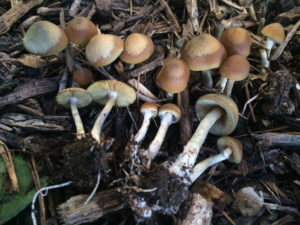
Maryland’s one Psilocybe is P. ovoideocystidiata[xvii]. It has no common name and is variable in color, anything from brown to white, with blue or green bruising. It is considered highly potent.
Gymnopilus
Gymnopilus is a large genus with just a few “active” members. It’s not well-known by psychonauts, with only a few published trip reports. It is said, though, to provide a qualitatively different[xviii] high than the Psilocybes do. Unfortunately, the taxonomy of the group is undergoing revision, to the point that it’s currently difficult to say which Gym is which. At least some do grow in Maryland, though.

My name is Austin Collins.
I've dedicated my life to Mushrooms.
I believe Mushrooms are the best kept secret when it comes to health and well being.
For that reason, I would like to share a company with you that in my opinion makes the best mushroom products on the market.
The company is called Noomadic Herbals, my favorite supplement they make is called "Mushroom Total".
I take their products every day and they have helped me think better and have more energy. Give them a try.
-Austin
References:
[i] (n.d.). Species List: Fungi of Rock Creek Park in Maryland and DC (333). Mushroom Observer
[ii] (n.d.). Species List: Maryland—Observations with DNA Support (1010). Mushroom Observer
[iii] Aaron, Susan (2020). Bicolor Bolete (Baorangia bicolor)–How to Find, ID, and Eat this Wild Gourmet Mushroom. Tyrant Farms
[iv] Kuo, M. (2015). Boletus bicolor. MushroomExpert
[v] (n.d.). Boletus auripes (“Butter Foot Bolete”). WPA Mushroom Club
[vi] (n.d.). Lanmaoa pseudosensibilis. WPA Mushroom Club
[vii] (n.d.). Boletus separans (“Lilac Bolete”). WPA Mushroom Club
[viii] (n.d.). Boletus variipes. WPA Mushroom Club
[ix] (n.d.). Amanita bisporigera. Amanitaceae.org
[x] (n.d.). Omphalotus illudens (Schwein.) Bresinsky & Besl—Jack O’Lantern. First Nature
[xi] (n.d.). Deadly Galerina (Galerina marginata (Batsch) Kühner 1935. MarylandBiodiversityProject
[xii] (n.d.). Galerina marginata (Batsch) Kühner—Funeral Bell. First Nature
[xiii] (n.d.). Which Psilocybin Mushrooms Grow Wild in My Area? Shroomery
[xiv] (n.d.). Panaeolus. Wikipedia
[xv] (n.d.). Panaeolus firmicola (Pers.) Gillet—Turf Mottlegill. First Nature
[xvi] (n.d.). Panaeolus cunctulus. Philosophy
[xvii] (n.d.). Psilocybe ovoideocystidiata Guzman et Gains. Shroomery
[xviii] Psycho Gnome (2014). Gymnopolus luteus found in Wisconsin (With Trip Report). Shroomery

